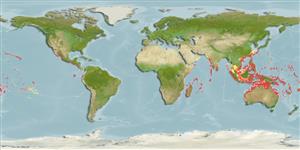Environment / Climate / Range
Ecology
Marine; reef-associated; depth range 1 - 73 m (Ref. 89467). Tropical, preferred ?; 30°N - 32°S
Indo-Pacific: East Africa south to Durban, South Africa (Ref. 4919) and east to the Panama, north to Ryukyu Islands, south to Lord Howe and Easter islands. Eastern Pacific: Guaymas, Mexico to Ecuador (Ref. 9349).
Size / Weight / Age
Maturity: Lm ? range ? - ? cm
Max length : 50.0 cm TL male/unsexed; (Ref. 9710)
Occurs in coral-rich areas of clear lagoon and seaward reefs, Ref. 48637. Prefers oceanic localities (Ref. 48637). Solitary (Ref. 90102). Benthopelagic (Ref. 58302). Feeds mainly on tips of branching corals and to a lesser extent on sponges, mollusks, bryozoans, tunicates, forams, algae, and detritus.
Life cycle and mating behavior
Maturity | Reproduction | Spawning | Eggs | Fecundity | Larvae
Myers, R.F., 1991. Micronesian reef fishes. Second Ed. Coral Graphics, Barrigada, Guam. 298 p. (Ref. 1602)
IUCN Red List Status (Ref. 115185)
CITES (Ref. 94142)
Not Evaluated
Threat to humans
Poisonous to eat (Ref. 4690)
Human uses
Aquarium: commercial
More information
ReferencesAquacultureAquaculture profileStrainsGeneticsAllele frequenciesHeritabilityDiseasesProcessingMass conversion
Tools
Special reports
Download XML
Internet sources
Estimates of some properties based on models
Phylogenetic diversity index (Ref.
82805): PD
50 = 0.5000 [Uniqueness, from 0.5 = low to 2.0 = high].
Bayesian length-weight: a=0.02692 (0.01222 - 0.05929), b=2.88 (2.70 - 3.06), in cm Total Length, based on LWR estimates for this (Sub)family-body shape (Ref.
93245).
Trophic Level (Ref.
69278): 3.6 ±0.0 se; Based on diet studies.
Resilience (Ref.
69278): Medium, minimum population doubling time 1.4 - 4.4 years (Preliminary K or Fecundity.).
Vulnerability (Ref.
59153): Low to moderate vulnerability (34 of 100) .
